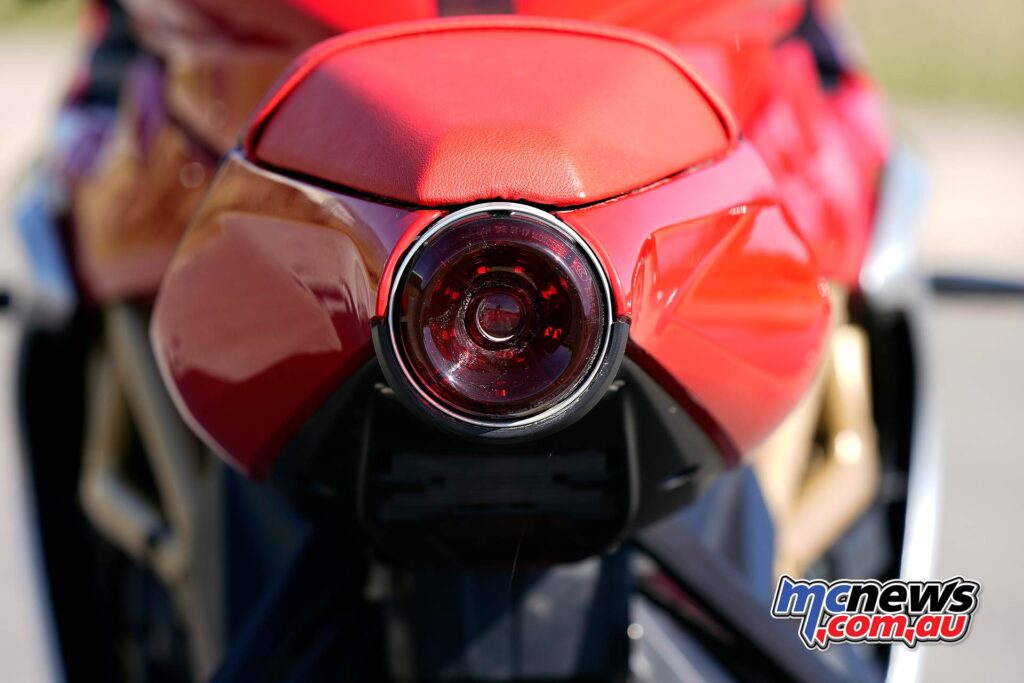Motorcycle Test by Adam Child ‘Chad’ – Photography Tim Keeton
When MV Agusta first unveiled the Superveloce in 2018, my jaw hit the floor. Now here with the actual production bike, which isn’t too far removed from the beautiful prototype, I’m in love again. She is stunning. Is there a more desirable, sexier, production bike on the market?
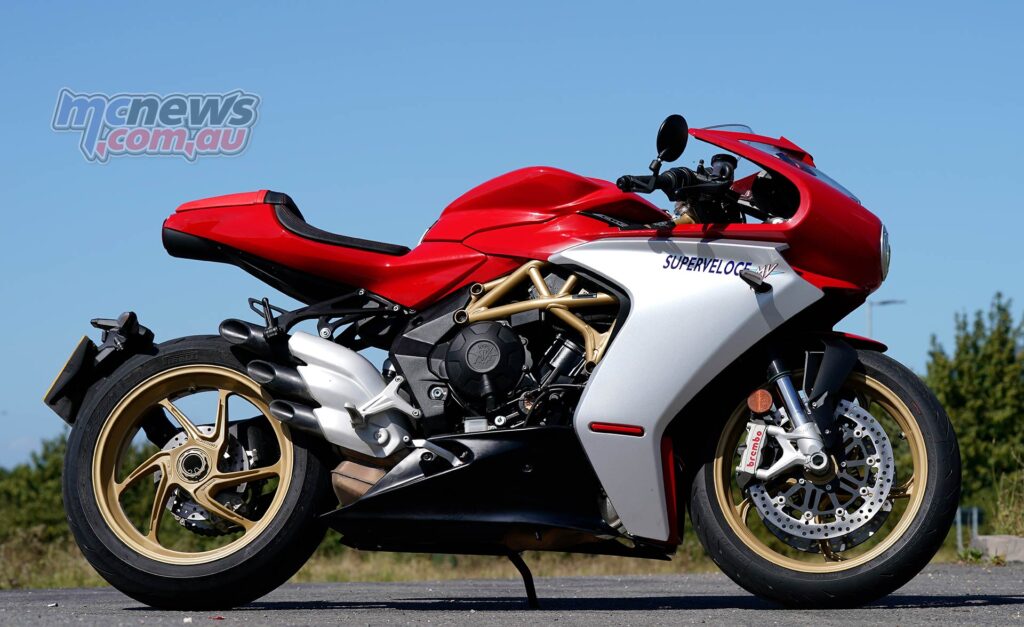
It’s unique, a throwback to the ’70s when MV dominated racing, it’s individual, daring, and produced in Italy by an iconic brand with an eye for detail.
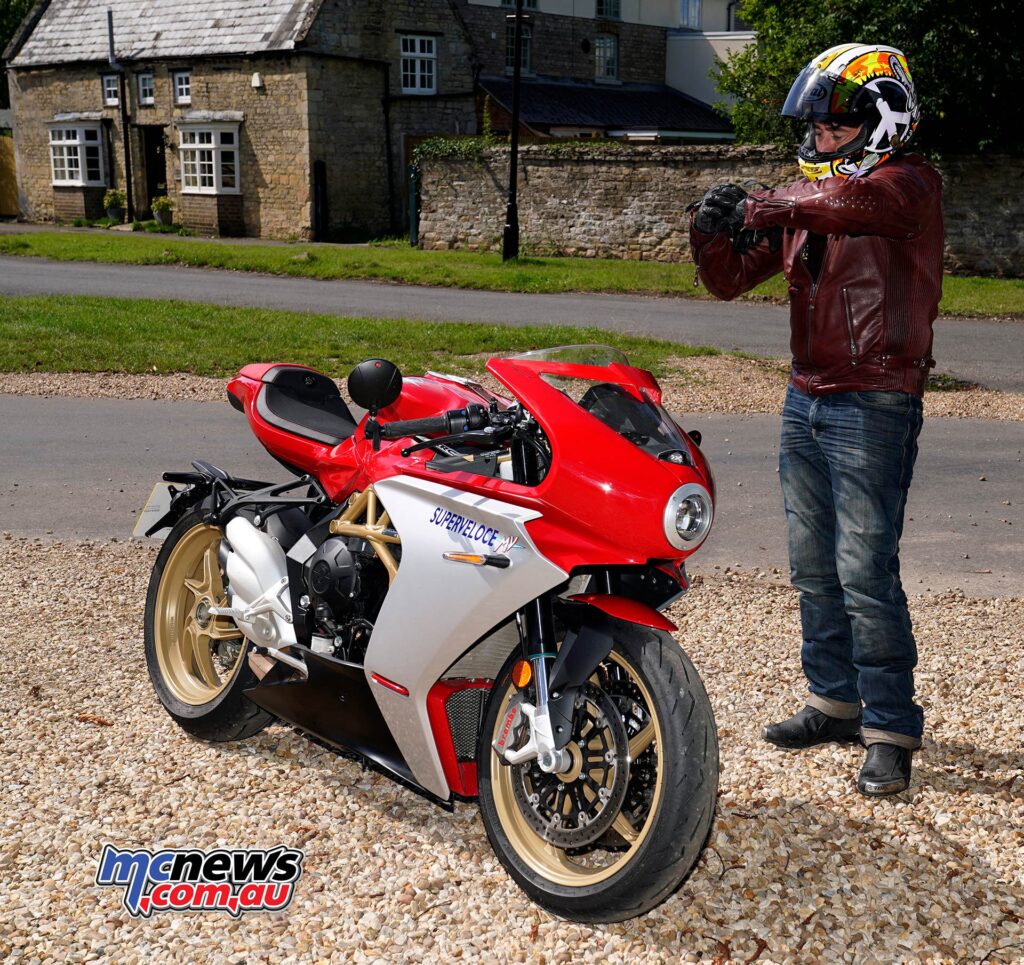
Check out the single LED head-light and tail-light, the protruding three exhausts give you an indication of it’s the engine, the ‘dummy’ leather strap over the fuel tanks, it is lavish, over the top, doesn’t have a purpose, but I still like it.
MV has hidden all the fairing fasteners and unsightly bolts, it gives the appearance the sculpted 70’s bodywork is floating – it’s the attention to detail and lavish styling I love.
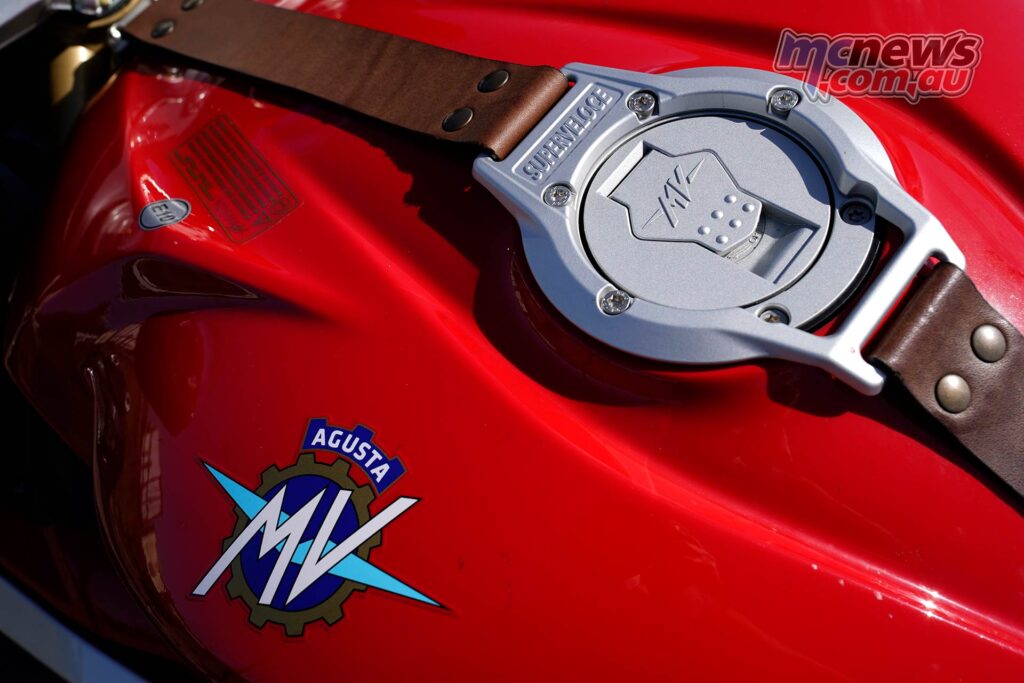
On looks alone, it must be one of the highlights of this motorcycle year, arguably the last five-years. It’s based on the highly acclaimed, track-focused, if slightly dated F3, so it should perform. But, does it go as well as it looks? A week in the UK and nearly 1500 kilometres should give us some answers.
Peak power and torque is identical to the MV F3 which was launched back in 2013, yes that long ago. Peak power is 148 ponies at 13,000 rpm while the 88 Nm of torque peaks at 10,600 rpm. The torque and power curves are identical between the two models, however the Superveloce has altered fuelling to compensate for the change in the air-box intake runners from the F3.
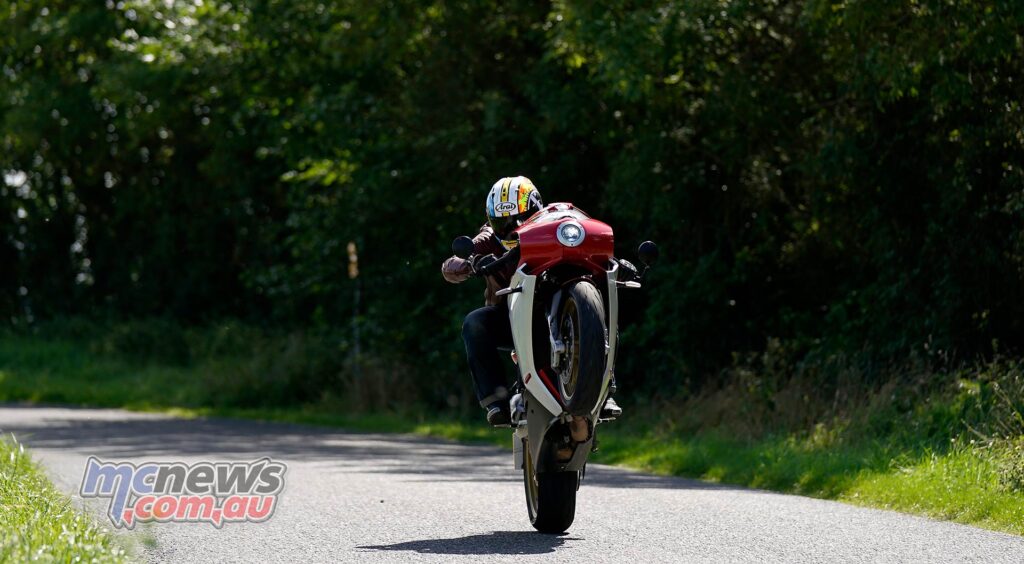
In today’s world where super-naked and superbikes are producing eye-watering power, the new MV may not have the power figures to impress mate down the pub, but in the real word, on the road, the power is impressive and usable. You don’t have to dance around on the gear selector in search of power, the three-cylinder, complete with counter-rotating crank, has usable power lower down in the rev range, then really starts to take off and run from the mid-range onwards. There are also four rider modes, Sport, Race, Rain and a Custom mode which changes the engine characteristics and throttle response.
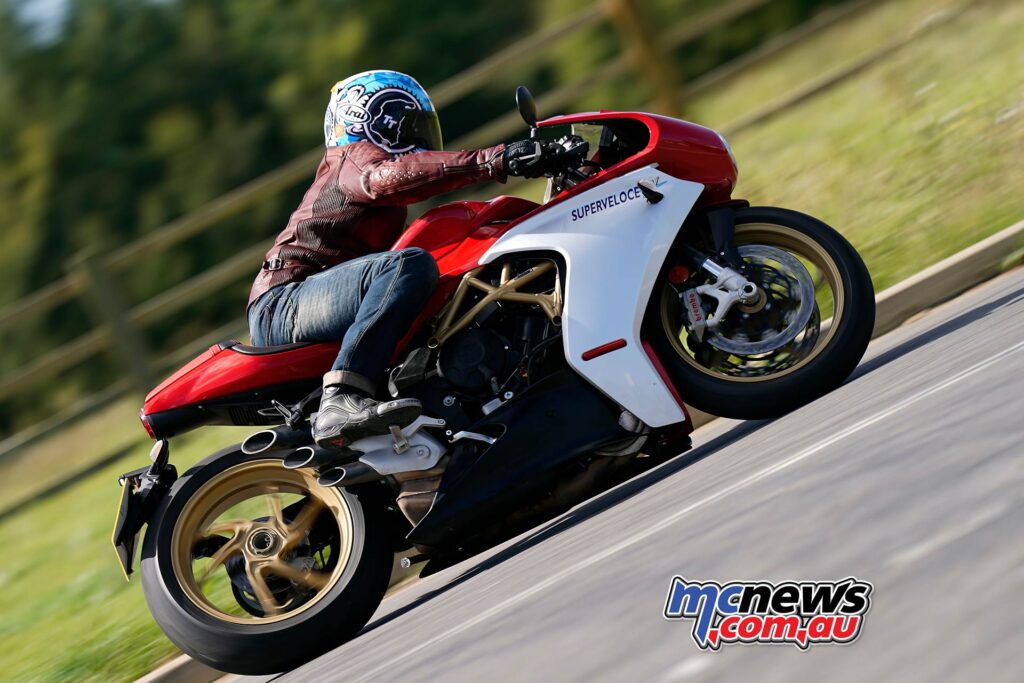
The three protruding exhausts sound as good as they look. MV always produces a lovely sounding bike and the Superveloce continues that tradition. In-line triple engines sound great, and despite passing Euro-4 legislation the MV sounds great via the 3-1-3 exhaust, more so as you send the digital rev-counter towards its redline. At tick-over its mildly humming, but still sounds unique. As the revs build so does its lung capacity, the MV is one of those bikes you just love to rev, just to hear the three exhausts holler.
On the road, you don’t really need to drop back a few gears for an overtake and you don’t have to leave every 50 km/h zone in second gear, there is more than enough usable torque, but because it sounds so good you can’t help but drop it back a few gears and let the engine roar. Gear changes are effortless, due to a super smooth box with up-down quick-shifter. The auto-blipper matches the revs every time on rapid down changes, and the cut in power on up changes is race bike like, smooth and fast – love it. Even at low speeds, around 50-60 km/h the clutchless changes felt smooth and fuss-free. On occasions, I did accidentally manage to find neutral between 1st and 2nd, but only a few times during an almost 1500-kilometre test.
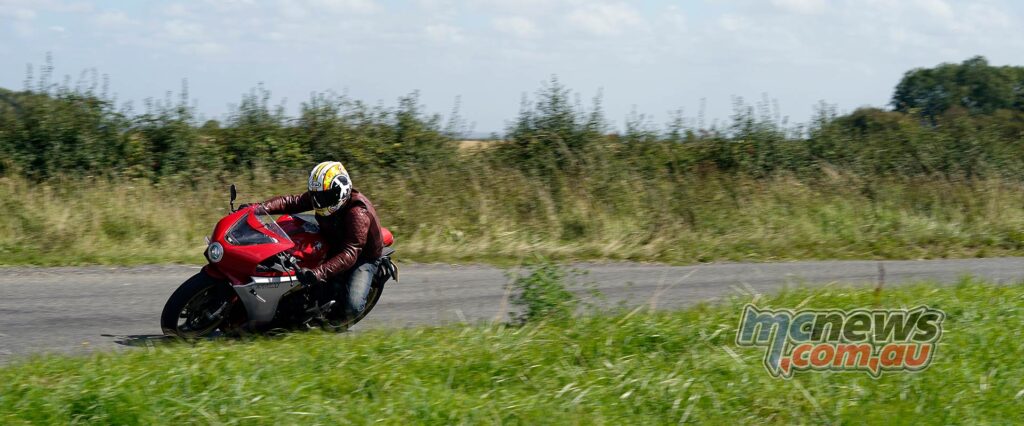
The upper half of the rev range is where the MV is the happiest though, in its element. Make no mistake the Superveloce is a quick bike, it might look like a 1970’s throwback, but underneath there is still an F3 engine which wants to run hard. In first gear, and occasionally in second gear, the eight-stage traction control system works overtime to keep the front wheel in contact with the ground. The counter-rotating crank, combined with a rider pushed forward over the top yoke makes for a bike that is not wheelie prone, you’re not fighting the front to keep it on the road, instead it just accelerates forward. However, if you do want to impress your mates it’s more than happy to loft the front, once you’ve deactivated the TC, which is easily done on the move, thanks to the easy-to-use full colour TFT clocks. The Superveloce may look like a work of art, but don’t be mistaken it’s still a 240 km/h sportsbike underneath that retro clothing. Usain Bolt in a 1970’s tracksuit.
Back in the real world, away from wheelies and top speed, MV has always been criticised for poor fuelling at low speeds. In Race mode, as you’d expect it’s a little harsh, but in Sport and Rain mode it softens and is easy-to-use. I, unfortunately, had to ride through a biblical rainstorm with lots of standing water and was thankful for the soft Rain mode in that instance.
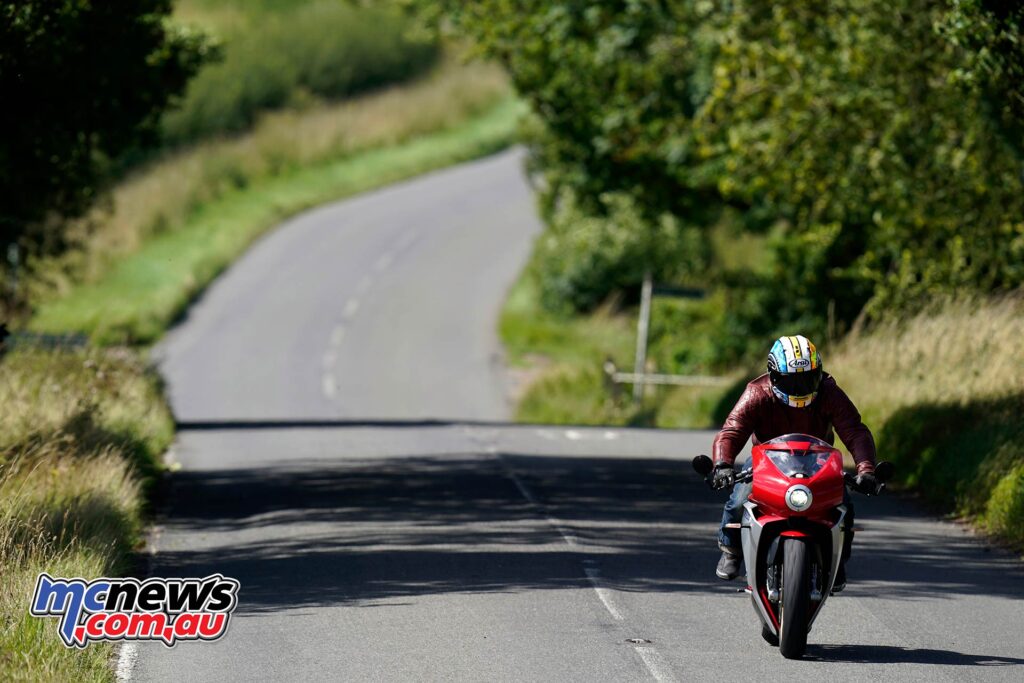
Fully-adjustable Marzocchi forks up front and fully-adjustable single Sachs unit at the rear is identical to the F3. But for this year MV has added a new progressive linkage on the rear and revised the fork settings. The overall set-up, as you’d expect, is on the sporty side, but it’s not overly harsh, this isn’t a race bike for the road. But equally this isn’t a softly sprung sports bike, like a Triumph Dayton Moto2 for example, it’s friendly, but only up to a point.
Like the engine the faster you ride the happier the suspension and handling is as it copes with braking, acceleration, and cornering loads with ease. You could roll out onto a track day with little complaints, the set-up is track-ready with standard tyres. The Superveloce feels at home on the fast, smooth, and flowing sections; at times I had to remind myself I wasn’t in race leathers and had to pull my knee in to avoid contact with the road.
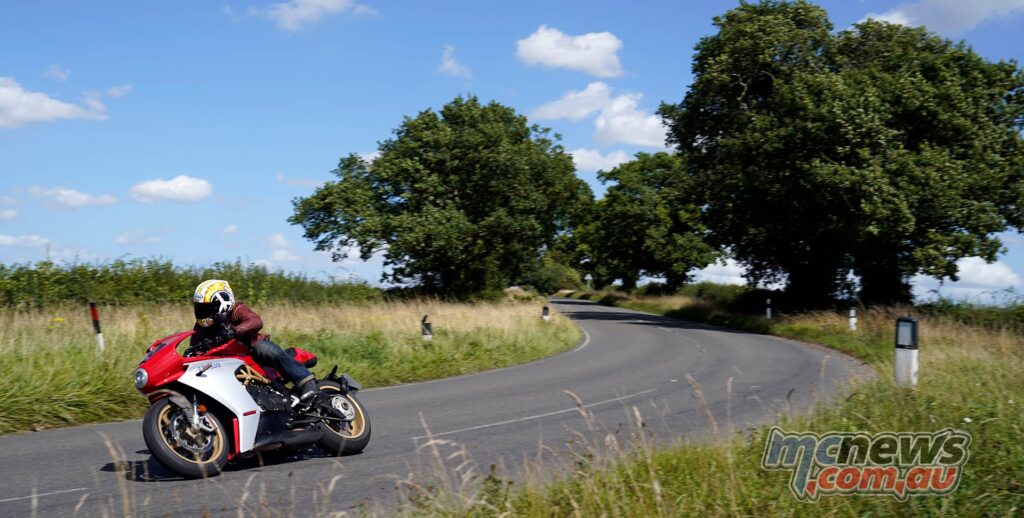
On bumpier, uneven sections of tarmac the MV doesn’t feel as accomplished as it did on the fast-smooth sections. It’s stable, it’s not overly harsh like MV’s new Brutale 1000RR, and again the faster you go, the more you load the suspension and the happier it feels. But on the odd occasion, the rear did jolt my spine. If I lived somewhere remote, used more B-roads than A, I’d certainly think about opening up the suspension to make it plusher, more road-focused than track.
Around town at slow speed, whilst constantly admiring your reflection you will grimace from time to time. Pot-holes and speed humps aren’t your friends. The riding position is on the radical side, the seat isn’t soft enough – don’t forget that black visor to hide your discomfort. But aside from posing why are you in town? Get away from the big smoke, allow the MV to breathe and enjoy the sportsbike handling.
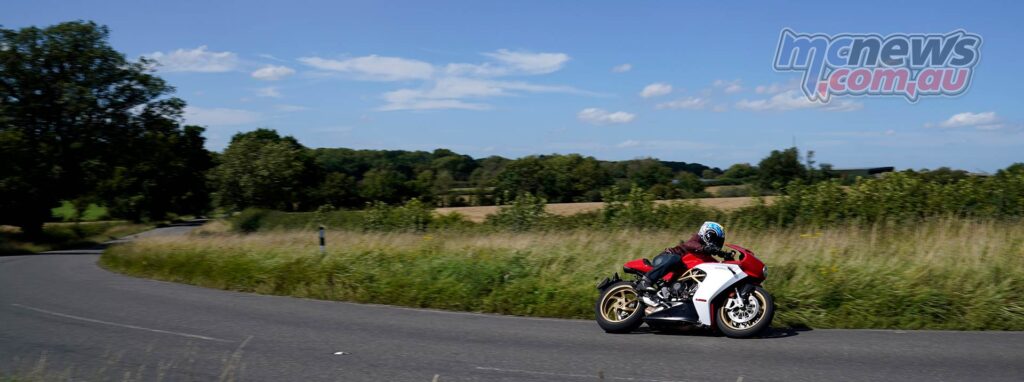
Like the suspension the Brembo radial stoppers are stolen from the F3, the same high quality set-up. Without an IMU to measure lean angle the ABS braking is conventional and not lean-sensitive. I never had a problem with conventional ABS but some riders/owners may have expected cornering ABS on a premium new 2020 model.
I rode the Superveloce in all conditions and was happy with the brake set-up. In the wet, the Pirelli Rosso Corsa 2 tyres are much better than they appear and the ABS isn’t too intrusive. In the dry the brake lever has a nice progressive feel to it, the Marzocchi forks dive smoothly in the stroke, not too rapidly, and rebound is quite well controlled. Overall the braking is impressive, as you’d expect from a bike based on the F3.
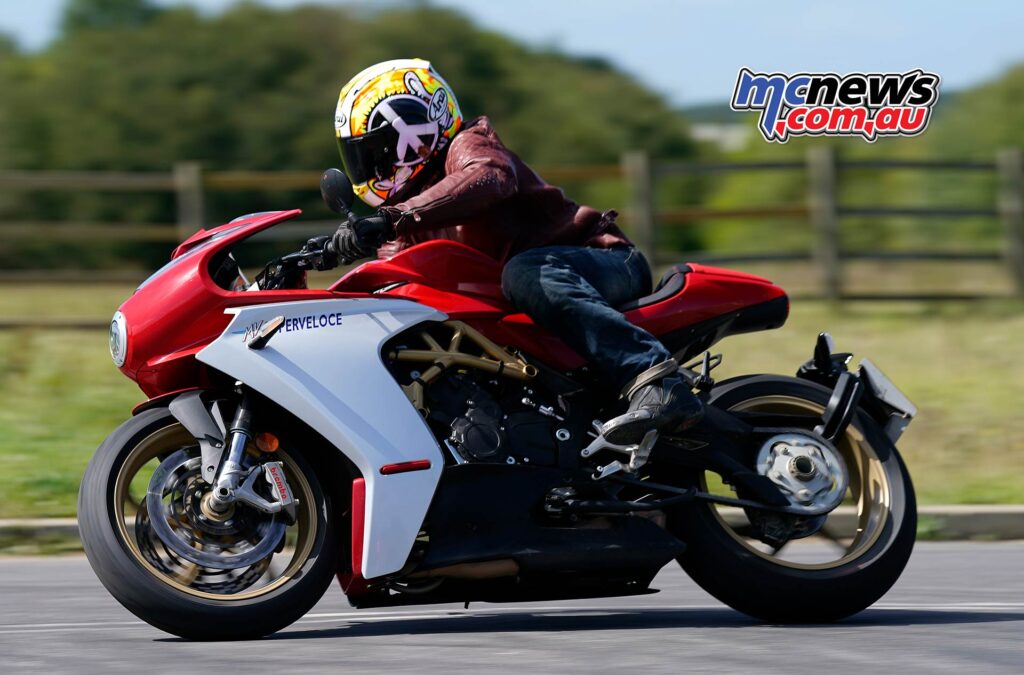
As mentioned earlier, the new Superveloce doesn’t have an IMU, therefore the eight-stage traction control isn’t lean-sensitive. However, traction control intervention and reintervention are smooth. Furthermore, it is a doddle to change on the move, I was up to the maximum setting of weight in the wet, while deactivating the TC for the wheelie photos, and this can all be done quite easily while on the move.
The all-new full-colour five-inch TFT clocks are easy to navigate and clear with simple graphics. The only downside is they are hard to read when the sun is low and behind the rider. I don’t have to scroll through various screens and sub-menus, it’s simple and intuitive. I love the new clocks, and unlike the MV 1000 Brutale 1000RR, they are in the correct position, behind the retro screen not near the fuel cap. Bluetooth connectivity and communication with the MV Ride App is another feature. Again, the app is simple and easy to use, you can track your ride, even change the settings like ABS and TC all from your phone. The rider modes are easy to change, again it’s simple this time done via the start button, but again in low light, it’s hard to read sometimes as Rain mode can look like Race mode, maybe they should have called them wet and track modes.
Cruise control is standard as does the up-and-down super smooth quick-shifter. Cruise control hints towards, dare I say it practicality, if you can say that about a retro MV with bar-end mirrors. Those mirrors, to be honest aren’t all that bad, surprisingly good in fact.
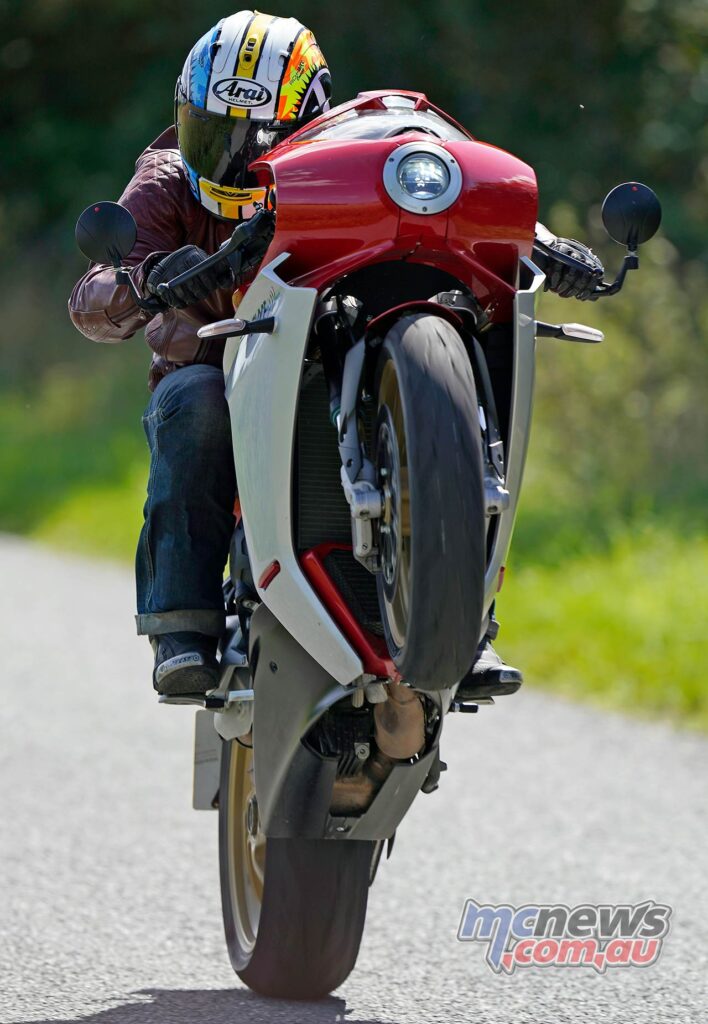
As you’d expect there are some lovely accessories to play with, carbon trinkets, the CNC aluminium spoked wheels are mouth-watering, and there’s an aftermarket Arrow race exhaust. The open exhaust for track use only… nudges power up to 150 ponies and looks stunning with two pipes exiting on the right and one on the left. I’m told, it sounds amazing, and I’m sure it does.
Verdict
In many ways we can simplify the new MV Superveloce down to this, it’s essentially a highly acclaimed F3 with new clocks, stunning styling, and revised suspension for 2020.
Take one of the best-handling bikes in your range, if not in the mid-capacity category as a whole, leave the stunning in-line triple alone, don’t fix what isn’t broke, make it sound great, cover it in unique, inspiring bodywork and styling. MV couldn’t go wrong really. I think it’s jaw-droppingly beautiful, and underneath is a motor and handing to match.
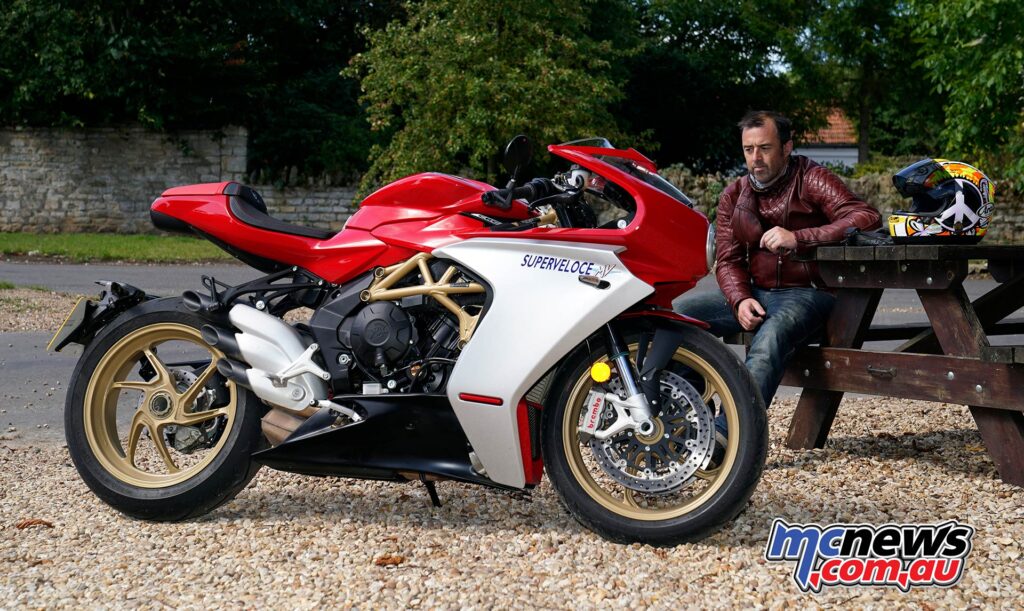
This is a true retro racer which in the right hands could indeed embarrass dedicated sports bikes on the track. It’s not the most comfortable, especially in town, the screen is too low on the motorway, and pillions will have to be brave or stupid. However, if you can live with the discomfort and the price, and yes MV dealers are sparse, then you’ll fall in love every time.
As you’d expect from MV, and like anything attractive from Italy, the new Superveloce is not exactly cheap but at $32,990 is not too ridiculous. The fact that MV Agusta Australia do include a three-year warranty, two-years road-side assist, and service intervals are a lengthy 15,000 kilometres does helpen to soften the blow. The first Australian stocks arrive later this month (September). There is also a new colour option recently announced (Link).
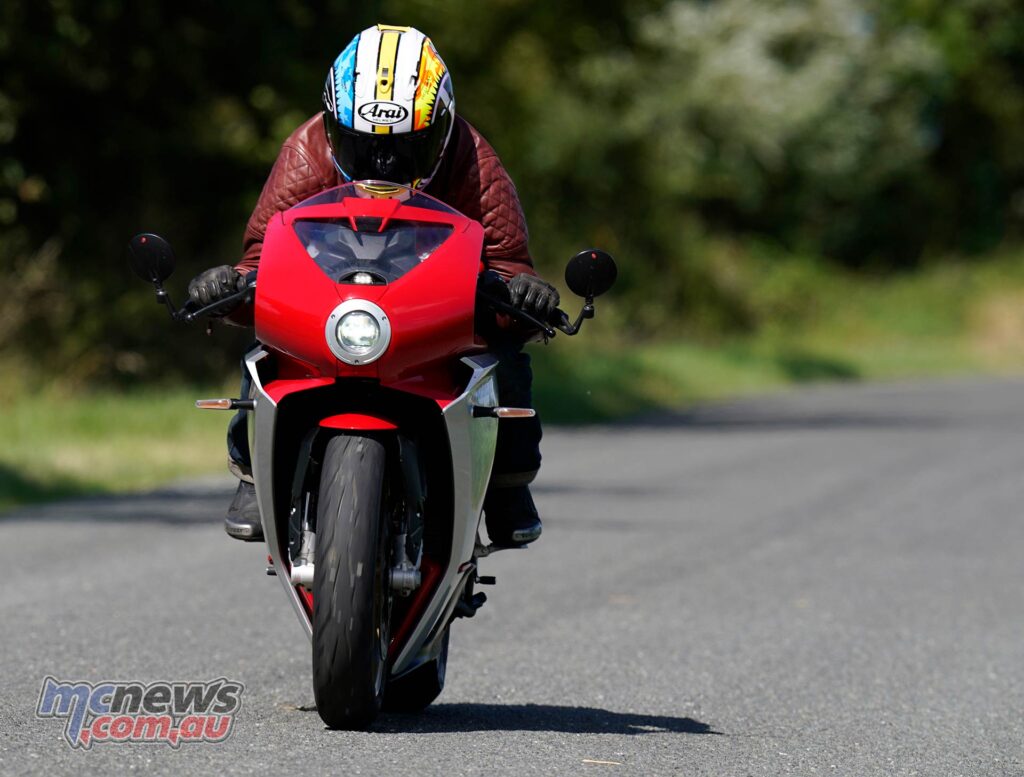
| MV Agusta Superveloce 800 Specifications | |
| Engine | 798 cc triple-cylinder four-stroke, 12-valve |
| Bore x Stroke | 79 x 54.3 mm |
| Compression Ratio | 13.3:1 |
| Claimed Power | 108 kW (148 hp) at 13,000 rpm |
| Claimed Torque | 88 Nm at 10,600 rpm |
| Induction | Integrated ignition – injection system MVICS (Motor & Vehicle Integrated Control System) with six injectors Engine control unit Eldor EM2.0, throttle body full ride by wire Mikuni, |
| Gears | Six-speed, MV EAS 2.1 (Electronically Assisted Shift Up & Down) |
| Clutch | Wet, slipper |
| Frame | ALS Steel tubular trellis |
| Forks | 43 mm Marzocchi “UPSIDE DOWN” telescopic hydraulic fork with rebound-compression damping and spring preload external and separate adjustment – 125 mm travel |
| Shock | Progressive Sachs, single shock absorber with rebound and compression damping and spring preload adjustment – 123 mm travel |
| Tyres | 120/70-17 (F) 180/55-17 (R) |
| Front Brakes | Double floating disc with Ø 320 mm (Ø 12.6 in.) diameter, with steel braking disc and flange – Brembo radial-type monobloc, with 4 pistons Ø 34 mm (Ø 1.34 in.) |
| Rear Brake | Single steel disc with Ø 220 mm (Ø 8.66 in.) dia. Brembo with 2 pistons – Ø 34 mm (Ø 1.34 in.) |
| Electronics | Torque control with four maps, Traction Control with eight levels of intervention. Bosch 9 Plus ABS with Race Mode and RLM (Rear wheel Lift-up Mitigation). Cruise control – Bluetooth – GPS – App MVride for navigation mirroring, app-controlled engine, rider aids setup |
| Instrumentation | TFT 5”color display |
| Dry Weight | 173 kg |
| Kerb Weight | NA |
| Seat Height | 830 mm |
| Wheelbase | 1380 mm |
| Rake / Trail | NA / 99 mm |
| Fuel Capacity | 16.5 litres |
| Service Intervals | 15,000 km / 12 months |
| Warranty | Three years, unlimited kilometres, two-years roadside assist |
| Available | September 2020 |
| Price | $32,990 ride-away |
